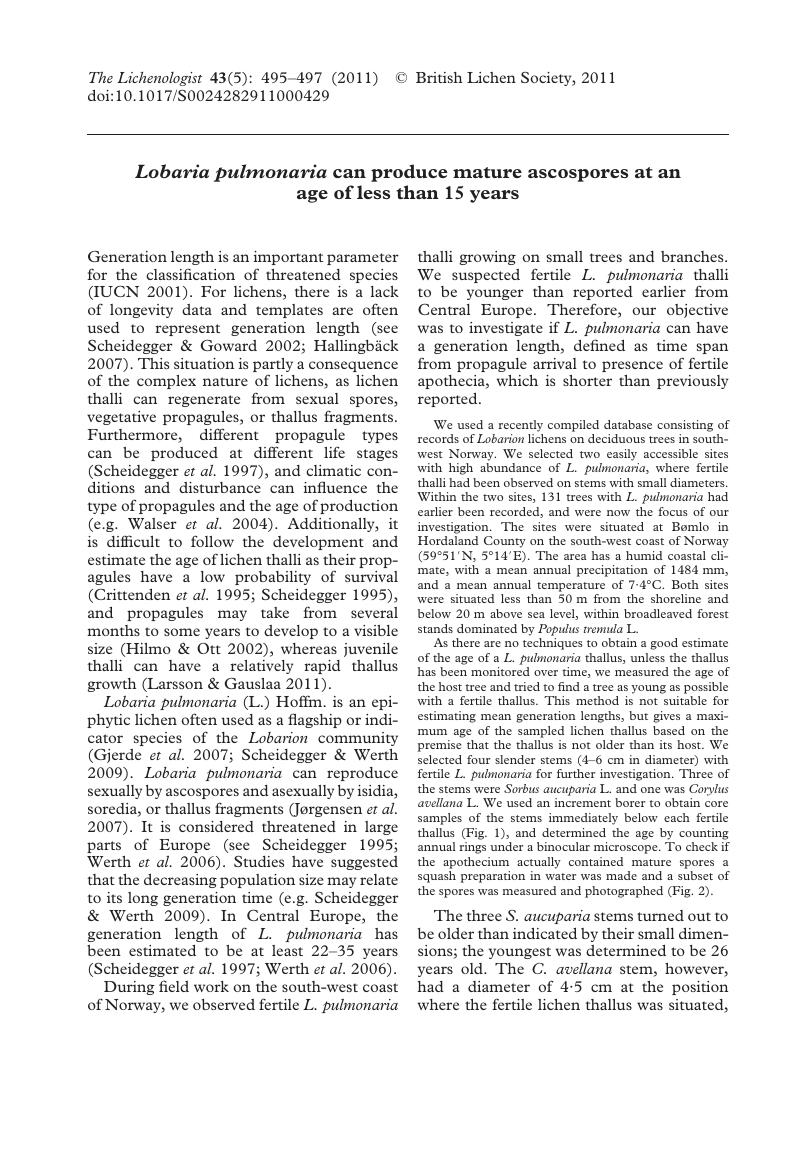Crossref Citations
This article has been cited by the following publications. This list is generated based on data provided by Crossref.
Hodkinson, Brendan P.
and
Hodkinson, Sarah Z.
2012.
Recent literature on lichens—224.
The Bryologist,
Vol. 115,
Issue. 1,
p.
183.
Singh, Garima
Dal Grande, Francesco
Cornejo, Carolina
Schmitt, Imke
Scheidegger, Christoph
and
Yun, Sung-Hwan
2012.
Genetic Basis of Self-Incompatibility in the Lichen-Forming Fungus Lobaria pulmonaria and Skewed Frequency Distribution of Mating-Type Idiomorphs: Implications for Conservation.
PLoS ONE,
Vol. 7,
Issue. 12,
p.
e51402.
Schei, Fride Høistad
Blom, Hans H.
Gjerde, Ivar
Grytnes, John-Arvid
Heegaard, Einar
and
Sætersdal, Magne
2013.
Conservation of epiphytes: Single large or several small host trees?.
Biological Conservation,
Vol. 168,
Issue. ,
p.
144.
Rolstad, Jørund
Ekman, Stefan
Andersen, Heidi Lie
and
Rolstad, Erlend
2013.
Genetic variation and reproductive mode in two epiphytic lichens of conservation concern: a transatlantic study ofEvernia divaricataandUsnea longissima.
Botany,
Vol. 91,
Issue. 2,
p.
69.
Eaton, Sally
and
Ellis, Christopher J.
2014.
High demographic rates of the model epiphyte Lobaria pulmonaria in an oceanic hazelwood (western Scotland).
Fungal Ecology,
Vol. 11,
Issue. ,
p.
60.
Nadyeina, Olga
Dymytrova, Lyudmyla
Naumovych, Anna
Postoyalkin, Sergyi
and
Scheidegger, Christoph
2014.
Distribution and dispersal ecology of Lobaria pulmonaria in the largest primeval beech forest of Europe.
Biodiversity and Conservation,
Vol. 23,
Issue. 13,
p.
3241.
Ellis, Christopher J.
2017.
When is translocation required for the population recovery of old‐growth epiphytes in a reforested landscape?.
Restoration Ecology,
Vol. 25,
Issue. 6,
p.
922.
Ellis, Christopher J.
2018.
A mechanistic model of climate change risk: Growth rates and microhabitat specificity for conservation priority woodland epiphytes.
Perspectives in Plant Ecology, Evolution and Systematics,
Vol. 32,
Issue. ,
p.
38.
Ivanova, N.V.
Shanin, V.N.
and
Shashkov, M.P.
2018.
Modelling the population dynamics of protected lichen species Lobaria pulmonaria at different forest management scenarios in even-aged pure stands in Kostroma region.
Vol. 7,
Issue. ,
Allen, Jessica L.
McKenzie, Sean K.
Sleith, Robin S.
and
Alter, S. Elizabeth
2018.
First genome‐wide analysis of the endangered, endemic lichen Cetradonia linearis reveals isolation by distance and strong population structure.
American Journal of Botany,
Vol. 105,
Issue. 9,
p.
1556.
Devkota, Shiva
Chaudhary, Ram Prasad
Werth, Silke
and
Scheidegger, Christoph
2019.
Genetic diversity and structure of the epiphytic foliose lichen Lobaria pindarensis in the Himalayas depends on elevation.
Fungal Ecology,
Vol. 41,
Issue. ,
p.
245.
Ametrano, Claudio G.
Lumbsch, H. Thorsten
Di Stefano, Isabel
Sangvichien, Ek
Muggia, Lucia
and
Grewe, Felix
2022.
Should we hail the Red King? Evolutionary consequences of a mutualistic lifestyle in genomes of lichenized ascomycetes.
Ecology and Evolution,
Vol. 12,
Issue. 1,



